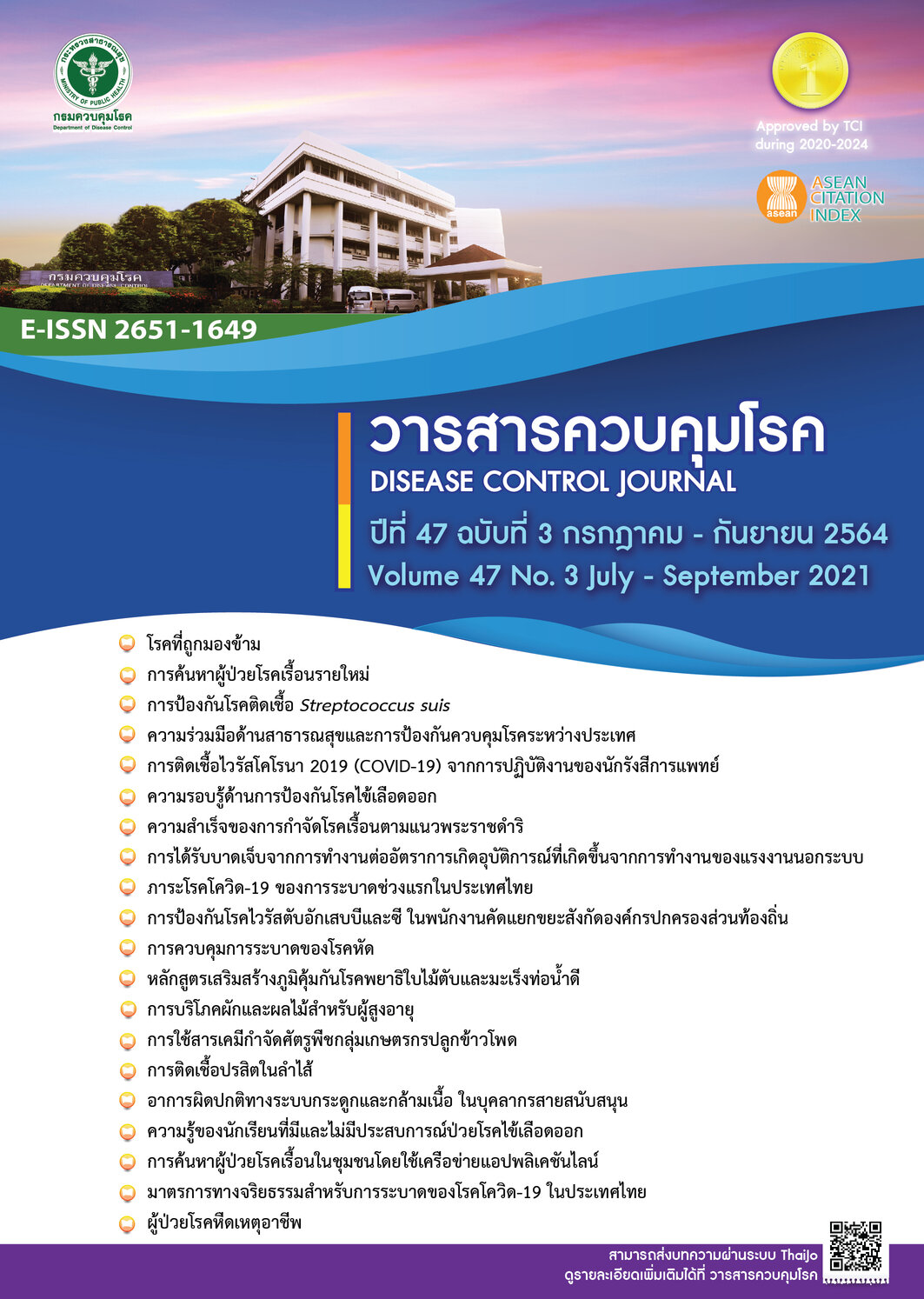Development of new leprosy case finding models for leprosy close contacts in Lower South of Thailand
DOI:
https://doi.org/10.14456/dcj.2021.39Keywords:
New leprosy case detection model, Leprosy close-contact, Deep South, Kingdom of ThailandAbstract
This action research (AR) aimed to develop new leprosy detecting model and describe its outputs among 10 index cases, who are newly diagnosed leprosy patients in Lower South Thailand between July and September 2017. The AR was divided into three parts: (1) preparation, (2) operation, and (3) evaluation. Quantitative data were collected using questionnaire and data recording form and were described using descriptive statistics. Qualitative data were gathered by field participatory and small-group reflection techniques and were analyzed using content analysis, constructivism and triangulation. We developed and implemented four models: (I) home visit, (II) Raj Pracha Samasai campaign and close contact tracing, (III) rapid village survey and close contact tracing, and (IV) integration to other health activities and close contact tracing. The results showed that 506 leprosy close contacts were identified and 179 of them (35.4%) were willing to participate in leprosy case finding processes. The case finding systems captured 3 leprosy patients, all patients were identified based-on model-II, and 5 primary cases of leprosy were revealed. Total case finding resulting from the models I to IV was 34.5%, 43.2%, 43.4%, and 14.3%, respectively. The reflection method showed that a development of new leprosy case finding system must be consistent with (1) un-arrested zone circumstance, (2) socio-cultural and indigenous believing platform, (3) stakeholders’ willingness to be involved, (4) model deploying’s time and traditional way of life, (5) knowledge and skills of health care providers and stakeholders, (6) prevalence of leprosy, and (7) leprosy and close-contact database. The development of leprosy case finding focusing on specific close contacts (Model II) provided the highest output. It also received high acceptance, co-operation from all stakeholders and had capacity to detect new leprosy cases.
Downloads
References
Noordeen SK. Elimination of leprosy as a public health problem: progress and prospects. Bulletin of the World Health Organization. 1995;73(1):1-6.
Department of Diseas Control. Rajprachasamasia Institute. Leprosy Geographical Inforamtion System2016 [Internet]. [cited 2019 Jan 12]. Available from:http://122.154.17.181: 8010/ lep_gis /index.php. (in Thai)
The Office of Disease Prevention and Control, 12 Songkhla. Registration and Name of Social Welfare Revenue in 12th Health Zone, B. E. 2563, among Leprosy with Disability in Community According to Department of Disease Control Leprosy Reimbursement Statute, B.E. 2557. (in Thai)
Teera Ramasoota.How to curb the incidence of leprosy. Journal of Preventive Medicine Association of Thailand. 2014;4(2):99-108.
Ditsuwan T. Guidelines for elimination of leprosy in the lower southern region;In the Decade Elimination Project in 7 provinces of lower southern Thailand. 2015.
Leprosy Eliminate Group. Guidelines for contact tracing register 2016 [Internet]. [citeก 2019 Jan 12]. Available from: http://thaileprosy.ddc. moph. go.th/ site/index.htm.
Smith W, Aerts A. Role of contact tracing and prevention strategies in the interruption of leprosy transmission. Lepr Rev. 2014;85(1):2-17.
Richardus JH, Meima A, van Marrewijk CJ, Croft RP, Smith TC. Close contacts with leprosy innewly diagnosed leprosy patients in a high and low endemic area: comparison between Bangladesh and Thailand. International journal of Leprosy. 2005;73(4):249-57.
Fine PE, Steme J, Pönnighaus J, Bliss L, Saul J, Chihana A, et al. Household and dwelling contact as risk factors for leprosy in northern Malawi. American journal of Epidemiology. 1997;146(1):91-102.
Van Beers SM, Hatta M, Klatser PR. Patient Contact is the Major Determinant in Incident Leprosy: Implications for Future Control. International Journal of Leprosy and Other Mycobacterial Diseases. 1999;67(2):119-28.
Department of Disease Control. Rajprachasamasia Institute. District area in Thailand focus on leprosy elimiation 2016 [Internet]. [citeก 2019 Jan 12]. Available from
http://thaileprosy.ddc.moph.go.th/site/documents/area/attachment-60_NewArea.pdf. (in Thai)
Thomas FÜrst, Arielle Cavaliero, Sambath Lay, Chrystel Dayer, Saren Chan, Ajda
Smrekar, Visal So, Tanja Barth-Jaeggi and Peter Steinmann. Retrospective active case finding in Cambodia: An innovative approach to leprosy control in a low-endemic country. Acta Tropica. 2018:26-32.
Andy A. Louhenapessy and Bos Zuiderhoek. A pracitcal method of active case finding and epidemiologiacl assessnet: Its origin and application in the leprosy control project in Indonesia. International Journal of Leprosy. 1997;65(4):487-91.
Charles Ezenduka, Erik Post, Steven John, Abdulkarim Suraj, Abdulahi Namadi and Obinna Onwujekwe. Cost-Effectiveness analysis of three leprosy case detection methods in Northern Nigeria. Plos Neglected Tropical Disease. 2012;6(9)e1818:1-8.
Stephen Kemmis RMT, Rhonda Nixon. Introducing critical participatory action research; chapter 1. In: Stephen Kemmis RMT, Rhonda Nixon, editor. The action research planner, Doing critical participatory action research: Springer Singapore Heidelberg New York: Dordrecht London; 2014.
Joungtraku J. Sample size and sampling issues in qualitative research. Journal of Business Administration and Social Sciences Ramkhamhaeng University. 2018;1(2):1-21 (in Thai)
Craig A. Mertler. Action research in education. 3 ed. Craig A. Mertler, editor: SAGE Publications; 2012.
Moet FJ, Pahan D, Schuring RP, Oskam L, Richardus JH. Physical distance, genetic relationship, age, and leprosy classification are independent risk factors for leprosy in contacts of patients with leprosy. The Journal of infectious diseases. 2006;193(3):346-53.
Moet FJ, Schuring RP, Pahan D, Oskam L, Richardus JH. The prevalence of previously undiagnosed leprosy in the general population of northwest Bangladesh. PLoS neglected tropical diseases. 2008;2(2):e198.
Downloads
Published
How to Cite
Issue
Section
License
Articles published in the Disease Control Journal are considered as academic work, research or analysis of the personal opinion of the authors, not the opinion of the Thailand Department of Disease Control or editorial team. The authors must be responsible for their articles.






